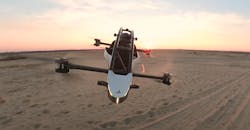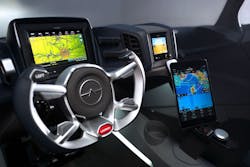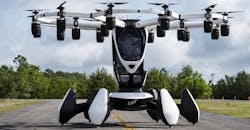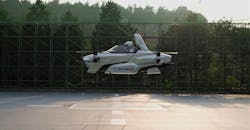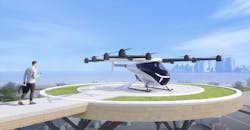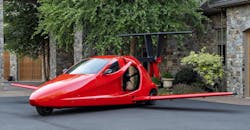Electric flight is taking off, thanks to photonics
If you think flying cars are a long way off, think again. By some counts, a staggering 700 designs for electric/hybrid-electric flying vehicles are in development, and many are already in the air.1 According to market research firm Markets and Markets, the global market for eVTOL aircraft was US$8.5 billion in 2021, projected to reach US$30.8 billion by 2030, a CAGR of 15%.
Where’s the money coming from? It’s a global effort of governments, mostly via agency programs and military-aerospace contractors, as well as aerospace corporations, airlines, automakers, corporations, venture capitalists, academia, and individuals. NASA, Boeing, Toyota, Uber, Intel, and the Massachusetts Institute of Technology are all invested, and that’s just a small slice in the U.S. alone. A frenzy of mergers, design wins, and production contracts are already leading to consolidation, because only a few dozen designs are ever likely to see commercialization.
The first commercially available recreational all-electric flying vehicles are hitting the market this year (see video). As of mid 2022, you can “pre-order” flying cars from Aeromobil (Bratislava, Slovakia) or Jetson Aero (Stockholm, Sweden; see Fig. 1).
The primary motivation to develop flying electric vehicles is the worldwide problem of urban traffic and its associated congestion, noise, fuel consumption, and pollution. The goal of advanced aerial mobility (AAM) or urban air mobility (UAM) is to use electric, autonomous urban air taxis and shuttles along air corridors from, for example, an airport to a train station, or the top of one building to another, to enable sustainable, clean transportation that is convenient, quiet, and saves time.
The most notable, common vehicle pursued in the UAM industry is the autonomous, “electric vehicle take-off-and landing” (eVTOL) aircraft. These lightweight, battery-powered air taxis are typically designed to be pilotless and driverless because they’re used for repetitive short-hop flights, much like the self-driving monorails in many large airports.
The cost of an on-demand ride-share flight, say several industry estimates, could someday be as low as $2/passenger mile, similar to UberX now for ground transport.
Leisure eVTOLs for one or two passengers are the first to reach the market. The ONE from Jetson Aero, a human-sized drone with a joystick, qualifies as an ultralight aircraft so it doesn’t require a pilot’s license. In the U.S. and many other countries, an operator can fly the Jetson ONE only during the day in rural locations, away from airport zones per Federal Aviation Administration (FAA) Part 103 regulations.
The ONE can fly at 63 mph (102 kph) for 20 minutes before recharging, and uses proprietary LiDAR-assisted obstacle and terrain avoidance. As with most other designs, safety provisions include double and even triple redundancy in the propulsion, flight computer, and parachute systems.2
The U.S. Air Force announced in June plans to procure five Hexa eVTOL models from startup Lift Aircraft (Austin, TX) as part of their AFWERX Agility Prime program, which aims to replace traditional helicopters with less expensive, fuel-efficient versions (see Fig. 4). The one-passenger, 18-rotor Hexa also qualifies as an ultralight; again, no pilot’s license required. Under-body floats allow it to make soft landings on both land and water.The AFWERX Agility Prime program budget includes $3.6 million to procure a total of 24 eVTOL aircraft for testing and evaluation from several emerging companies in FY2023, including Lift, Phenix Solutions (McMinnville, OR), Joby Aviation (Santa Cruz, CA), Elroy Air (South San Francisco, CA), Moog (Elma, NY), and Beta Technologies (South Burlington, VT).
Barriers
While regulations and lack of infrastructure are still a barrier, many eVTOLs designed for the UAM market are conquering them one certification and country at a time. Japanese startup SkyDrive (Tokyo Japan), a spinout from all-volunteer flying vehicle company Cartivator, announced in September its latest model eVTOL for UAM, the SD-05. This fifth-generation flying vehicle, a drone-like, 12-propeller ultralight for the leisure/commuter market, is designed to carry two passengers, one being the pilot, with a cargo capacity of 1100 lb (500 kg) over a range of 31 miles (50 km) at 62 mph (100 kph; see Figs. 4-6). In March 2022, the Japan Civil Aviation Bureau (JCAB) accepted SkyDrive’s “type certification” application, which leads the way to examining airworthiness, safety standards, and eventually production certification. Similar procedures apply in the U.S. with the FAA.Pending certification, SkyDrive plans to unveil a working air taxi service at the World Expo in Osaka in 2025, where it will shuttle passengers from point to point over a circular route. Furthermore, the company announced in September that it raised 9.6 billion yen in its Series C round of financing and has opened a U.S. office to facilitate plans to provide “last mile” air transportation between airports and common destinations.
“SkyDrive’s emission-free flying vehicles are designed to be able to take off from and land in small spaces like parking lots and helipads atop buildings, making flying vehicles a realistic choice for daily transportation,” says SkyDrive CEO Tomohiro Fukuzawa.
In late July, the Switchblade piloted electric-hybrid roadable plane from Samson Sky (Redmond, OR) received FAA clearance for flight testing, after which it claimed to be the first flying car available in the U.S. market (see Fig. 7).The wings of the three-wheel, two-seater Switchblade fold to convert it from a small plane to a drivable car. For $170,000, buyers will need to spend about 1 week to self-assemble at least 51% of the Switchblade with trained technicians to qualify it as an experimental aircraft with the FAA. As a gas-powered hybrid-electric vehicle requiring a 1100-ft (335 m) runway to take off and a shorter 700 ft (213 m) landing strip, the Switchblade is not a VTOL, nor is it all-electric (yet), but like many eVTOL companies, Samson’s early design was focused on getting airborne first, with future plans to transition to pilotless, all-electric designs in the future.
LiDAR on a chip
One important photonics technology making autonomous electric flight safer is ever-smaller LiDAR sensors, which use pulses of laser light (UV, visible, or near-IR) to sense the changing distances to objects and surfaces. LiDAR systems for autonomous vehicles can send out millions of laser points per second to create a real-time 3D point cloud of everything around the vehicle. LiDAR appears in the designs of approximately two dozen publicly announced eVTOL designs, including those of Airbus (Leiden, Netherlands), Archer Aviation (Palo Alto, CA), Wisk Aero (Mountain View, CA), Mobileye (Jerusalem, Israel), and Jetson.
Newly public LiDAR startup Luminar (Palo Alto, CA) is leveraging its chip-based 3D LiDAR mapping capabilities for vehicles on the ground into eVTOLs and other future flight technologies in the air. Luminar, which currently powers the autonomous driving capabilities for Volvo, Audi, and Daimler’s trucking division, announced last year a partnership with Airbus UpNext (Madrid, Spain), a subsidiary of the European aerospace contractor, to apply its LiDAR mapping technology to a variety of novel aircraft under development. The chip-based LiDAR enables ultracompact, reliable, inexpensive optical sensors that can guide autonomous obstacle avoidance and landings.
Successful proof of concept using chip-based LiDAR will help Airbus UpNext develop safer autonomous flight designs. Other Luminar partners in the autonomous flight space include Intel’s Mobileye and the Toyota Research Institute.
Another LiDAR startup, Voyant Photonics (New York, NY), received a $15.4 million round of funding in March this year to develop its frequency-modulated continuous-wave (FMCW) solid-state LiDAR technology. Voyant’s LiDAR places tens of thousands of optoelectronic components, including an optical phased array and beam-steering capabilities, onto a single chip centered in the eye-safe region at 1550 nm.
Consuming only 1.8 W of power, the technology can map the velocity of moving objects out to a range of hundreds of meters, making it useful in eVTOL applications that require compact, inexpensive, but very sensitive LiDAR. This latest multi-million-dollar investment will allow the company to send out its first test kits to customers on a waiting list later this year. Voyant expects their commercial solid-state LiDAR to launch in the first or second quarter of 2023.
The majority of flying electric vehicle designs for passengers are likely to be piloted first, while unpiloted vehicles will handle cargo only. Piloted eVTOL designs will have semi-automated pilot-assist features, which will eventually transition to unpiloted, fully autonomous flight.
Like many companies, Archer and Joby plan to enter the market with on-board pilots before transitioning to full automation. In December, Joby’s S4 aircraft was the first eVTOL design to receive airworthiness approval from the FAA. Both Archer and Joby expect to achieve complete FAA certification to enter service in 2024.
Flight paths for taxi services will largely be on repetitive, exclusive corridors. Auto-pilot technology originated in planes, so it makes sense for eVTOLs. Many companies say removing the human element means removing human error from the endeavor, the primary cause of most aviation accidents.
Vehicles on the ground have obstacles such as debris, pedestrians, curbs, and other cars, whereas designated air corridors would have fewer obstacles. Bird strike prevention strategy will be similar for eVTOLs as it is for planes: naturally a big “bird” will repel smaller birds, especially one with bold color and markings. Nevertheless, eVTOLs, like small planes, will need to be built to withstand strikes.
The ultimate stage in “eVTOLution” will be unpiloted automated vehicles, although several companies are cutting out the human and going directly to unpiloted flying vehicles. For example, in January, Wisk received $450 million from Boeing to develop self-flying electric air taxis with human ground-based operators; in October, the company announced plans to advance its Gen 6 four-passenger autonomous electric air taxi to the FAA for type certification. Pilotless air travel may become commonplace before driverless vehicles.
REFERENCES
1. See Evtol.news.
2. See https://youtu.be/GAVwYIvmNEM.
About the Author
Valerie Coffey-Rosich
Contributing Editor
Valerie Coffey-Rosich is a freelance science and technology writer and editor and a contributing editor for Laser Focus World; she previously served as an Associate Technical Editor (2000-2003) and a Senior Technical Editor (2007-2008) for Laser Focus World.
Valerie holds a BS in physics from the University of Nevada, Reno, and an MA in astronomy from Boston University. She specializes in editing and writing about optics, photonics, astronomy, and physics in academic, reference, and business-to-business publications. In addition to Laser Focus World, her work has appeared online and in print for clients such as the American Institute of Physics, American Heritage Dictionary, BioPhotonics, Encyclopedia Britannica, EuroPhotonics, the Optical Society of America, Photonics Focus, Photonics Spectra, Sky & Telescope, and many others. She is based in Palm Springs, California.
